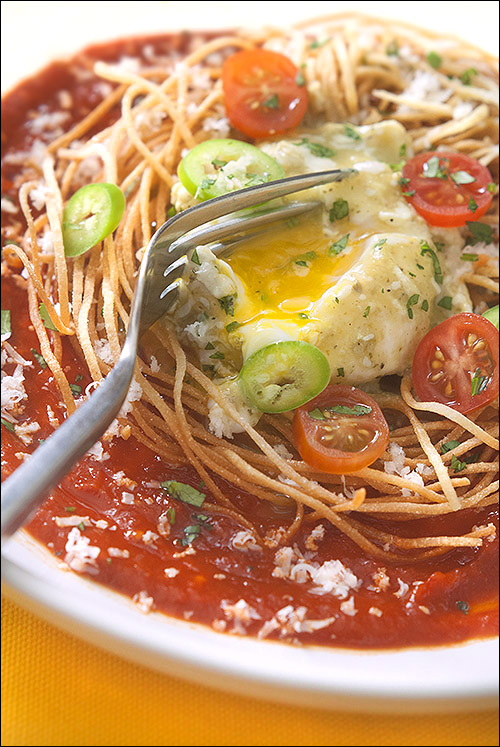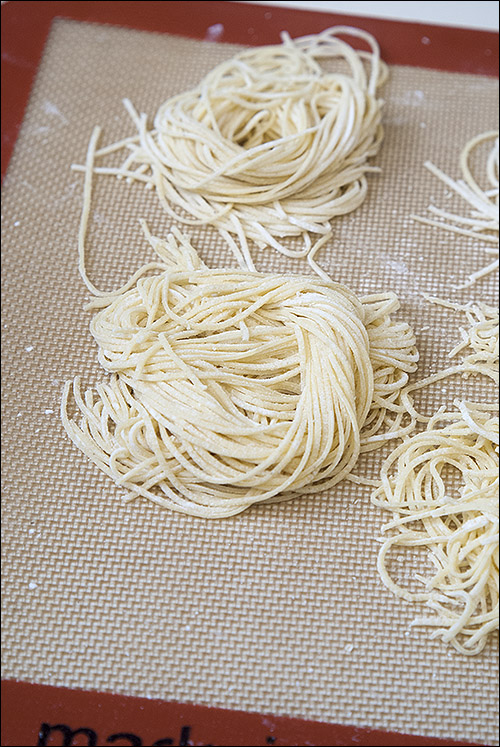 |
| Huevos ahogados with crispy masa nest. © Ryan Schierling |
For the last decade, we've prepared Scotch eggs on the first of January, which are hard-boiled eggs, peeled and wrapped in heavily-spiced breakfast sausage, breaded, and deep-fried. They are ridiculously satisfying, delicious dragged through tangy HP sauce, but so intense and heavy we could only justify eating them once a year. So we've been thinking about this since... last New Year's eggs.
Maybe it was time for a change?
For 2015, we adapted a Mexican poached egg dish, huevos ahogados – drowned eggs – with a pair of sauces and a fried masa nest. It was so simple when we concepted it months ago. It ended up absolutely ridiculous when we were trying to figure out the nest. It was silly, and better than it had any right to be once we figured it out, prepared, brought everything together and ate it.
I don't expect you to make it. You will need a pasta maker with a spaghetti-cutting attachment. You will need a tiny one-quart saucepan. You will need patience, and probably a few mimosas. You will need dried guajillo chiles. You will need masa and hot oil and the rest of the day to clean up your frying mess.
But, if you do decide to make it, it will probably only be once per annum, and it really is worth it. The sauces play beautifully together, and the crispy masa threads add a delicate texture and subtle corn flavor that put this plate over the top. It's a small serving, more of a breakfast appetizer, but it's a special dish for a special day. If you're going to start out a new year right, you might as well go ridiculous.
Huevos Ahogados with Crispy Masa Nest
First, prepare the guajillo sauce, salsa verde and masa nests (recipes below).
Slice up a handful of cherry tomatoes and a few fresh serrano peppers. Crumble some cotija or añejo, and finely chop a handful of cilantro. These are your garnishes.
When the salsa verde is at a simmer, crack a fresh, cold egg into a ramekin or small bowl. Gently drop the egg into the salsa and cook about 5 minutes for soft yolks. Remove with a slotted spoon.
On a warmed plate, ladle out a thin layer of guajillo sauce. Place a crispy masa nest in the middle of the plate and put your salsa-poached egg in the middle of the nest. Season the egg with salt. Drizzle a little of the warm salsa verde over the egg and nest. Garnish with sliced tomatoes, serrano, cilantro and cotija or añejo.
Guajillo Sauce
4 ounces dried guajillo chiles
1 tablespoon kosher salt
1/2 cup soaking water or filtered water (see below)
1 pound fresh ripe tomatoes, halved
1/2 pound fresh tomatillos, paper husks removed
6 cloves of garlic
1/2 large white onion
Olive oil
2 tablespoons piloncillo, or brown sugar
2 tablespoons olive oil
1/2 teaspoon kosher salt
1/2 cup water (if needed for thinning sauce)
Tear or cut stems off tops of the guajillo chiles. Split and open the dry chiles and remove seeds and membranes. On a hot, dry comal or skillet (we prefer cast iron) toast chiles until they are fragrant, a few seconds on each side. We used a spatula to press the chiles flat against the comal.
Place toasted chiles in a bowl, cover with boiling water and put a plate over the bowl to hold the chiles down in the liquid. Soak for about 20 minutes, until chiles are rehydrated. Remove chiles from liquid (reserving liquid) and place in a blender with 1/2 teaspoon salt. Taste the reserved liquid. If it is not bitter, add 1/2 cup to the chiles in the blender, otherwise just use water. Blend to into a soft paste (should make about 1 cup) and scrape into a medium saucepan.
On a foil-lined baking sheet, arrange tomatoes (cut side up), tomatillos, garlic cloves (peel on) and onion half and drizzle all with olive oil. Roast in 350º F oven for approximately 40 minutes. When cool enough to handle, put the tomatoes, tomatillos and onion in the blender, squeezing the roasted garlic out of the skins into the blender as well. Purée (should make about 2 cups), then strain through a fine-mesh sieve into the medium saucepan.
Bring this mixture to a simmer, allowing the mixture to reduce by up to 25 percent. Add the piloncillo (or brown sugar), olive oil and 1/2 teaspoon salt (or adjust to taste). If mixture is too thick for your preference, add a little bit of water.
Keep warm for plating.
Salsa Verde
1 pound tomatillos, paper husks removed
2 serrano peppers, stems removed
1/2 white onion
6 cloves garlic, peeled
2 limes, juiced
2 cups water
1/4 cup cilantro
1 tablespoon Mexican oregano
1 tablespoon agave
Salt to taste
Preheat broiler, place oven rack in the second-highest position about 4 inches below the broiler. Put tomatillos, stemmed serranos, and onion on a baking sheet. Drizzle with olive oil and place under the broiler until starting to char and become very fragrant, about 5 minutes. Put broiled tomatillos, serranos, and onion in a blender. Add garlic cloves to the blender. Add 1 cup water and pulse until everything is incorporated. Add cilantro, oregano, agave and salt and puree. Pour into a medium saucepan, add lime juice, the remaining water, and salt to taste.
Bring to a low simmer over medium heat. This is what you'll be poaching your eggs in.
Masa Nest
1 cup masa harina de maiz (instant corn masa flour, such as Maseca®)
1/2 cup semolina flour
Pinch of salt
1 egg
1 egg yolk
1/2 cup water (approximately)
Vegetable oil
Corn starch and all-purpose flour for dusting pasta while rolling.
Mix dry ingredients in food processor. Add eggs, pulse until incorporated and crumbly. Add water until dough can hold its shape when pinched, but not sticky. Turn out onto floured board and knead for about 10 minutes until dough is feeling smooth and holding together. Form into four portions and wrap with plastic wrap. Allow to rest for 30 minutes in the fridge.
Use a 1:1 mixture of corn starch and AP flour for dusting. Roll through pasta machine to thinness level 4, then through the small cutting roller (spaghetti-size on typical Atlas-type pasta makers.)
 |
| Cut masa threads, ready to fry. © Ryan Schierling |
We used a 6" saucepan because the masa threads will spread out in the hot oil to whatever diameter pan you're using. The bigger your pan, the more the masa will spread, and will be more difficult to remove in one piece.
Cook time is brief, only until the masa threads are beginning to brown (30-45 seconds depending on oil temperature and recovery). Gently lift the nest out of the oil and place on a wire rack with paper towels underneath. Season with kosher salt.
Makes 8 nests.

No comments:
Post a Comment
We welcome comments. Thanks for your patience as we moderate to avoid spam and other internet foolishness.